吴裕雄--天生自然 Tensorflow卷积神经网络:花朵图片识别
- import os
- import numpy as np
- import matplotlib.pyplot as plt
- from PIL import Image, ImageChops
- from skimage import color,data,transform,io
- #获取所有数据文件夹名称
- fileList = os.listdir("F:\\data\\flowers")
- trainDataList = []
- trianLabel = []
- testDataList = []
- testLabel = []
- #读取每一种花的文件
- for j in range(len(fileList)):
- data = os.listdir("F:\\data\\flowers\\"+fileList[j])
- #取每一种花四分之一的数据作为测试数据集
- testNum = int(len(data)*0.25)
- #把每种花的图片进行testNum次乱序处理
- while(testNum>0):
- np.random.shuffle(data)
- testNum -= 1
- #把每种花经过乱序后的四分之三当作训练集
- trainData = np.array(data[:-(int(len(data)*0.25))])
- #把每种花经过乱序后的四分之一当作测试集
- testData = np.array(data[-(int(len(data)*0.25)):])
- #从上面选出来的训练集中逐张读取出对应的图片
- for i in range(len(trainData)):
- #其中这些图片都要满足jpg格式的
- if(trainData[i][-3:]=="jpg"):
- #读取一张jpg图片
- image = io.imread("F:\\data\\flowers\\"+fileList[j]+"\\"+trainData[i])
- #把这张图片变成64*64大小的图片
- image=transform.resize(image,(64,64))
- #保存改变大小的图片到trainDataList列表
- trainDataList.append(image)
- #保存这张图片的标签到trianLabel列表
- trianLabel.append(int(j))
- #随机生成一个角度,这个角度的范围在顺时针90度和逆时针90度之间
- angle = np.random.randint(-90,90)
- #然后把上面那张64*64大小的图片随机旋转angle个角度
- image =transform.rotate(image, angle)
- #把旋转得到的新图片再变成64*64大小的,因为旋转会改变一张图片的大小
- image=transform.resize(image,(64,64))
- #把旋转后并且大小是64*64的图片保存到trainDataList列表
- trainDataList.append(image)
- #把旋转后并且大小是64*64的图片对应的标签保存到trianLabel列表
- trianLabel.append(int(j))
- #逐张读取每种花的测试图片
- for i in range(len(testData)):
- #选取的图片要满足jpg格式的
- if(testData[i][-3:]=="jpg"):
- #读取一张图片
- image = io.imread("F:\\data\\flowers\\"+fileList[j]+"\\"+testData[i])
- #改变这张图片的大小为64*64
- image=transform.resize(image,(64,64))
- #把改变后的图片保存到testDataList列表中
- testDataList.append(image)
- #把这张图片对应的标签保存到testLabel列表中
- testLabel.append(int(j))
- print("图片数据读取完了...")

- #打印训练集和测试数据集以及它们对应标签的规模
- print(np.shape(trainDataList))
- print(np.shape(trianLabel))
- print(np.shape(testDataList))
- print(np.shape(testLabel))

- #保存训练集和测试数据集以及它们对应标签到磁盘
- np.save("G:\\trainDataList",trainDataList)
- np.save("G:\\trianLabel",trianLabel)
- np.save("G:\\testDataList",testDataList)
- np.save("G:\\testLabel",testLabel)
- print("数据处理完了...")

- import numpy as np
- from keras.utils import to_categorical
- #将训练数据集和测试数据集对应的标签转变为one-hot编码
- trainLabel = np.load("G:\\trianLabel.npy")
- testLabel = np.load("G:\\testLabel.npy")
- trainLabel_encoded = to_categorical(trainLabel)
- testLabel_encoded = to_categorical(testLabel)
- np.save("G:\\trianLabel",trainLabel_encoded)
- np.save("G:\\testLabel",testLabel_encoded)
- print("转码类别写盘完了...")

- import random
- import numpy as np
- trainDataList = np.load("G:\\trainDataList.npy")
- trianLabel = np.load("G:\\trianLabel.npy")
- print("数据加载完了...")
- trainIndex = [i for i in range(len(trianLabel))]
- random.shuffle(trainIndex)
- trainData = []
- trainClass = []
- for i in range(len(trainIndex)):
- trainData.append(trainDataList[trainIndex[i]])
- trainClass.append(trianLabel[trainIndex[i]])
- print("训练数据shuffle完了...")
- np.save("G:\\trainDataList",trainData)
- np.save("G:\\trianLabel",trainClass)
- print("训练数据写盘完毕...")

- X = np.load("G:\\trainDataList.npy")
- Y = np.load("G:\\trianLabel.npy")
- print(np.shape(X))
- print(np.shape(Y))

- import random
- import numpy as np
- testDataList = np.load("G:\\testDataList.npy")
- testLabel = np.load("G:\\testLabel.npy")
- testIndex = [i for i in range(len(testLabel))]
- random.shuffle(testIndex)
- testData = []
- testClass = []
- for i in range(len(testIndex)):
- testData.append(testDataList[testIndex[i]])
- testClass.append(testLabel[testIndex[i]])
- print("测试数据shuffle完了...")
- np.save("G:\\testDataList",testData)
- np.save("G:\\testLabel",testClass)
- print("测试数据写盘完毕...")

- X = np.load("G:\\testDataList.npy")
- Y = np.load("G:\\testLabel.npy")
- print(np.shape(X))
- print(np.shape(Y))
- print(np.shape(testData))
- print(np.shape(testLabel))

- import tensorflow as tf
- from random import shuffle
- INPUT_NODE = 64*64
- OUT_NODE = 5
- IMAGE_SIZE = 64
- NUM_CHANNELS = 3
- NUM_LABELS = 5
- #第一层卷积层的尺寸和深度
- CONV1_DEEP = 16
- CONV1_SIZE = 5
- #第二层卷积层的尺寸和深度
- CONV2_DEEP = 32
- CONV2_SIZE = 5
- #全连接层的节点数
- FC_SIZE = 512
- def inference(input_tensor, train, regularizer):
- #卷积
- with tf.variable_scope('layer1-conv1'):
- conv1_weights = tf.Variable(tf.random_normal([CONV1_SIZE,CONV1_SIZE,NUM_CHANNELS,CONV1_DEEP],stddev=0.1),name='weight')
- tf.summary.histogram('convLayer1/weights1', conv1_weights)
- conv1_biases = tf.Variable(tf.Variable(tf.random_normal([CONV1_DEEP])),name="bias")
- tf.summary.histogram('convLayer1/bias1', conv1_biases)
- conv1 = tf.nn.conv2d(input_tensor,conv1_weights,strides=[1,1,1,1],padding='SAME')
- tf.summary.histogram('convLayer1/conv1', conv1)
- relu1 = tf.nn.relu(tf.nn.bias_add(conv1,conv1_biases))
- tf.summary.histogram('ConvLayer1/relu1', relu1)
- #池化
- with tf.variable_scope('layer2-pool1'):
- pool1 = tf.nn.max_pool(relu1,ksize=[1,2,2,1],strides=[1,2,2,1],padding='SAME')
- tf.summary.histogram('ConvLayer1/pool1', pool1)
- #卷积
- with tf.variable_scope('layer3-conv2'):
- conv2_weights = tf.Variable(tf.random_normal([CONV2_SIZE,CONV2_SIZE,CONV1_DEEP,CONV2_DEEP],stddev=0.1),name='weight')
- tf.summary.histogram('convLayer2/weights2', conv2_weights)
- conv2_biases = tf.Variable(tf.random_normal([CONV2_DEEP]),name="bias")
- tf.summary.histogram('convLayer2/bias2', conv2_biases)
- #卷积向前学习
- conv2 = tf.nn.conv2d(pool1,conv2_weights,strides=[1,1,1,1],padding='SAME')
- tf.summary.histogram('convLayer2/conv2', conv2)
- relu2 = tf.nn.relu(tf.nn.bias_add(conv2,conv2_biases))
- tf.summary.histogram('ConvLayer2/relu2', relu2)
- #池化
- with tf.variable_scope('layer4-pool2'):
- pool2 = tf.nn.max_pool(relu2,ksize=[1,2,2,1],strides=[1,2,2,1],padding='SAME')
- tf.summary.histogram('ConvLayer2/pool2', pool2)
- #变型
- pool_shape = pool2.get_shape().as_list()
- #计算最后一次池化后对象的体积(数据个数\节点数\像素个数)
- nodes = pool_shape[1]*pool_shape[2]*pool_shape[3]
- #根据上面的nodes再次把最后池化的结果pool2变为batch行nodes列的数据
- reshaped = tf.reshape(pool2,[-1,nodes])
- #全连接层
- with tf.variable_scope('layer5-fc1'):
- fc1_weights = tf.Variable(tf.random_normal([nodes,FC_SIZE],stddev=0.1),name='weight')
- if(regularizer != None):
- tf.add_to_collection('losses',tf.contrib.layers.l2_regularizer(0.03)(fc1_weights))
- fc1_biases = tf.Variable(tf.random_normal([FC_SIZE]),name="bias")
- #预测
- fc1 = tf.nn.relu(tf.matmul(reshaped,fc1_weights)+fc1_biases)
- if(train):
- fc1 = tf.nn.dropout(fc1,0.5)
- #全连接层
- with tf.variable_scope('layer6-fc2'):
- fc2_weights = tf.Variable(tf.random_normal([FC_SIZE,64],stddev=0.1),name="weight")
- if(regularizer != None):
- tf.add_to_collection('losses',tf.contrib.layers.l2_regularizer(0.03)(fc2_weights))
- fc2_biases = tf.Variable(tf.random_normal([64]),name="bias")
- #预测
- fc2 = tf.nn.relu(tf.matmul(fc1,fc2_weights)+fc2_biases)
- if(train):
- fc2 = tf.nn.dropout(fc2,0.5)
- #全连接层
- with tf.variable_scope('layer7-fc3'):
- fc3_weights = tf.Variable(tf.random_normal([64,NUM_LABELS],stddev=0.1),name="weight")
- if(regularizer != None):
- tf.add_to_collection('losses',tf.contrib.layers.l2_regularizer(0.03)(fc3_weights))
- fc3_biases = tf.Variable(tf.random_normal([NUM_LABELS]),name="bias")
- #预测
- logit = tf.matmul(fc2,fc3_weights)+fc3_biases
- return logit
- import time
- import keras
- import numpy as np
- from keras.utils import np_utils
- X = np.load("G:\\trainDataList.npy")
- Y = np.load("G:\\trianLabel.npy")
- print(np.shape(X))
- print(np.shape(Y))
- print(np.shape(testData))
- print(np.shape(testLabel))
- batch_size = 10
- n_classes=5
- epochs=16#循环次数
- learning_rate=1e-4
- batch_num=int(np.shape(X)[0]/batch_size)
- dropout=0.75
- x=tf.placeholder(tf.float32,[None,64,64,3])
- y=tf.placeholder(tf.float32,[None,n_classes])
- # keep_prob = tf.placeholder(tf.float32)
- #加载测试数据集
- test_X = np.load("G:\\testDataList.npy")
- test_Y = np.load("G:\\testLabel.npy")
- back = 64
- ro = int(len(test_X)/back)
- #调用神经网络方法
- pred=inference(x,1,"regularizer")
- cost=tf.reduce_mean(tf.nn.softmax_cross_entropy_with_logits(logits=pred,labels=y))
- # 三种优化方法选择一个就可以
- optimizer=tf.train.AdamOptimizer(1e-4).minimize(cost)
- # train_step = tf.train.GradientDescentOptimizer(0.001).minimize(cost)
- # train_step = tf.train.MomentumOptimizer(0.001,0.9).minimize(cost)
- #将预测label与真实比较
- correct_pred=tf.equal(tf.argmax(pred,1),tf.argmax(y,1))
- #计算准确率
- accuracy=tf.reduce_mean(tf.cast(correct_pred,tf.float32))
- merged=tf.summary.merge_all()
- #将tensorflow变量实例化
- init=tf.global_variables_initializer()
- start_time = time.time()
- with tf.Session() as sess:
- sess.run(init)
- #保存tensorflow参数可视化文件
- writer=tf.summary.FileWriter('F:/Flower_graph', sess.graph)
- for i in range(epochs):
- for j in range(batch_num):
- offset = (j * batch_size) % (Y.shape[0] - batch_size)
- # 准备数据
- batch_data = X[offset:(offset + batch_size), :]
- batch_labels = Y[offset:(offset + batch_size), :]
- sess.run(optimizer, feed_dict={x:batch_data,y:batch_labels})
- result=sess.run(merged, feed_dict={x:batch_data,y:batch_labels})
- writer.add_summary(result, i)
- loss,acc = sess.run([cost,accuracy],feed_dict={x:batch_data,y:batch_labels})
- print("Epoch:", '%04d' % (i+1),"cost=", "{:.9f}".format(loss),"Training accuracy","{:.5f}".format(acc*100))
- writer.close()
- print("########################训练结束,下面开始测试###################")
- for i in range(ro):
- s = i*back
- e = s+back
- test_accuracy = sess.run(accuracy,feed_dict={x:test_X[s:e],y:test_Y[s:e]})
- print("step:%d test accuracy = %.4f%%" % (i,test_accuracy*100))
- print("Final test accuracy = %.4f%%" % (test_accuracy*100))
- end_time = time.time()
- print('Times:',(end_time-start_time))
- print('Optimization Completed')
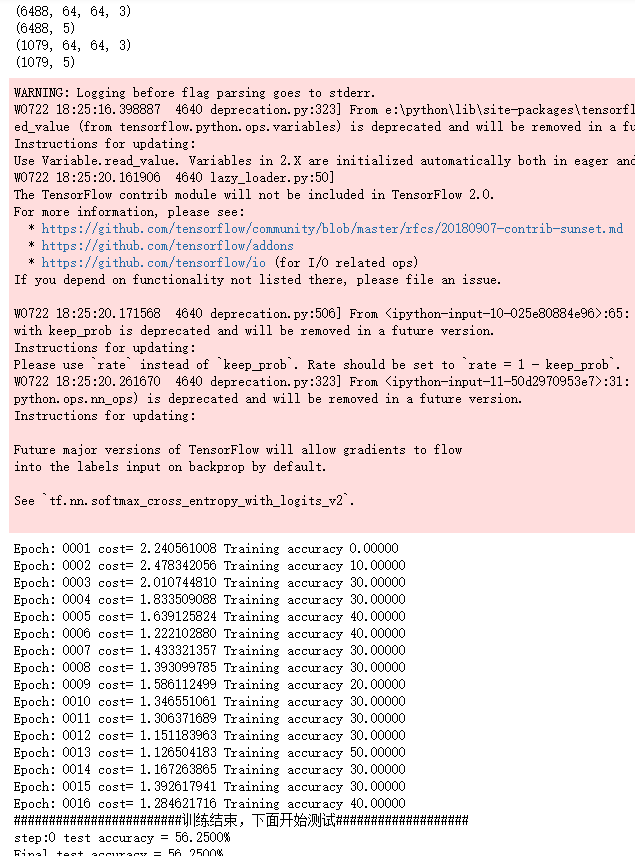
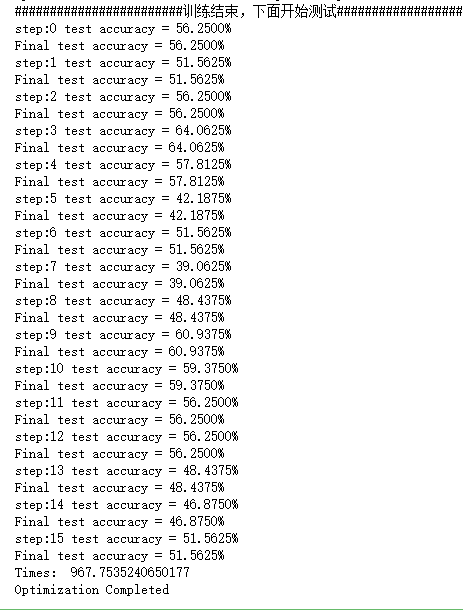

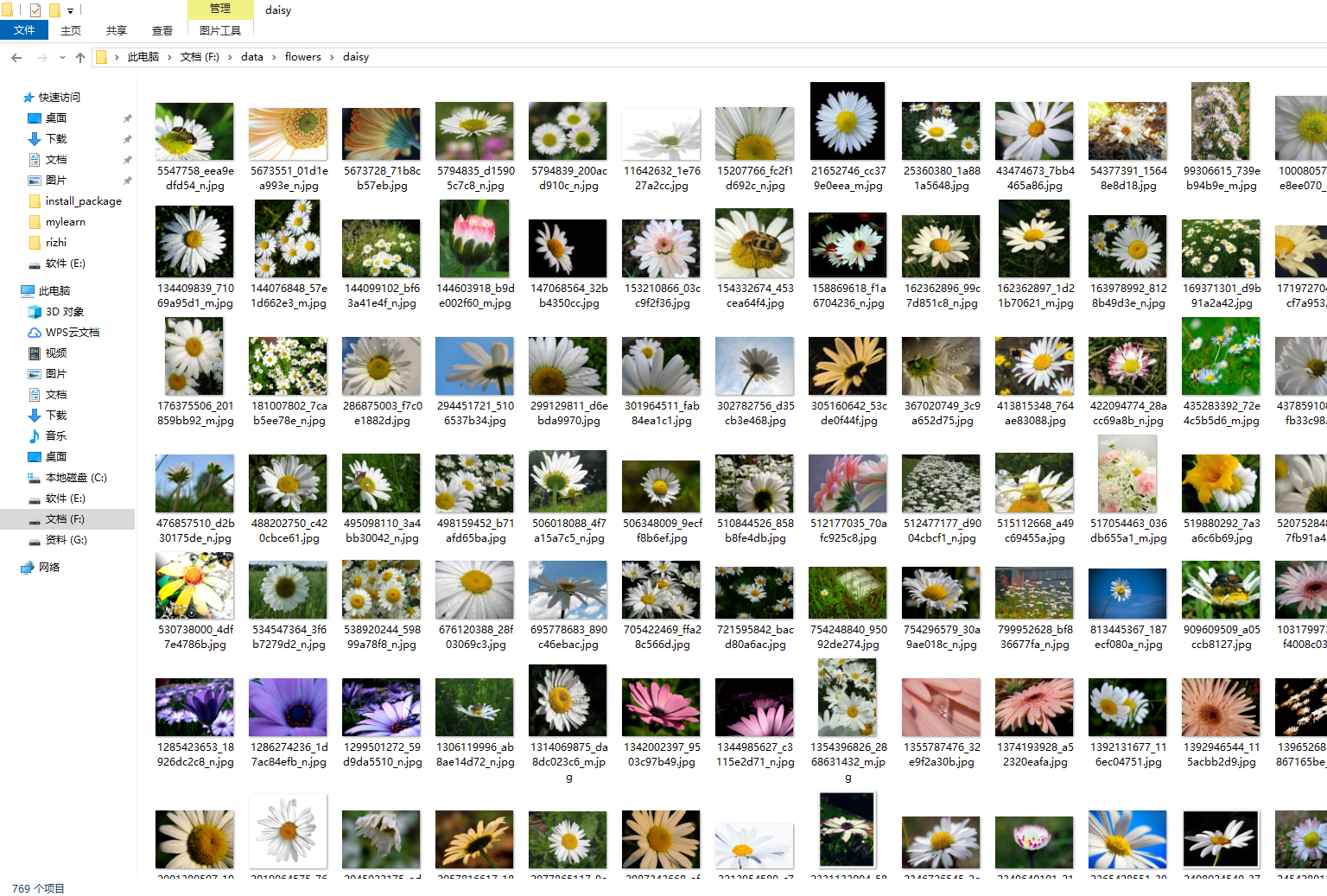

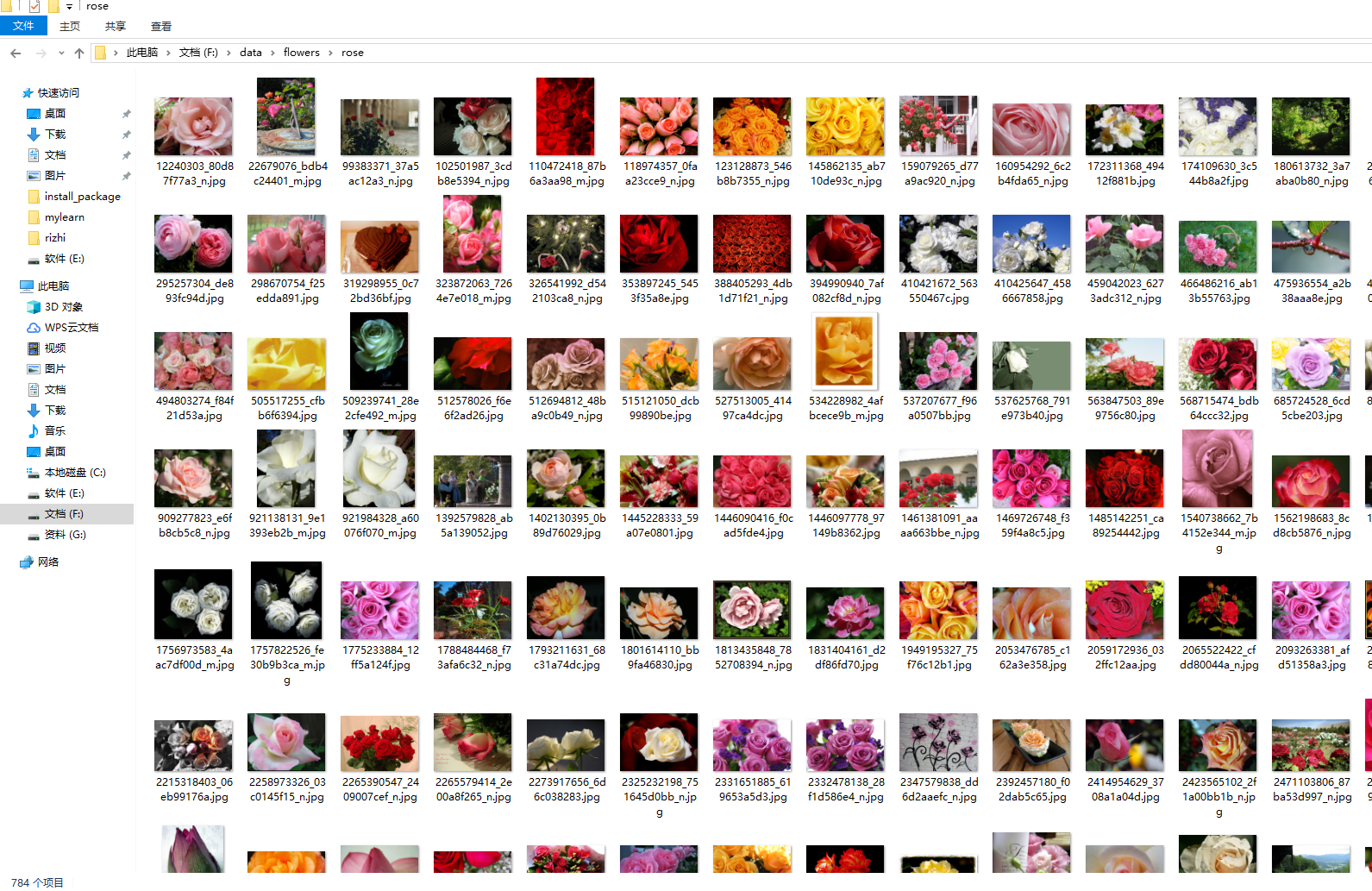
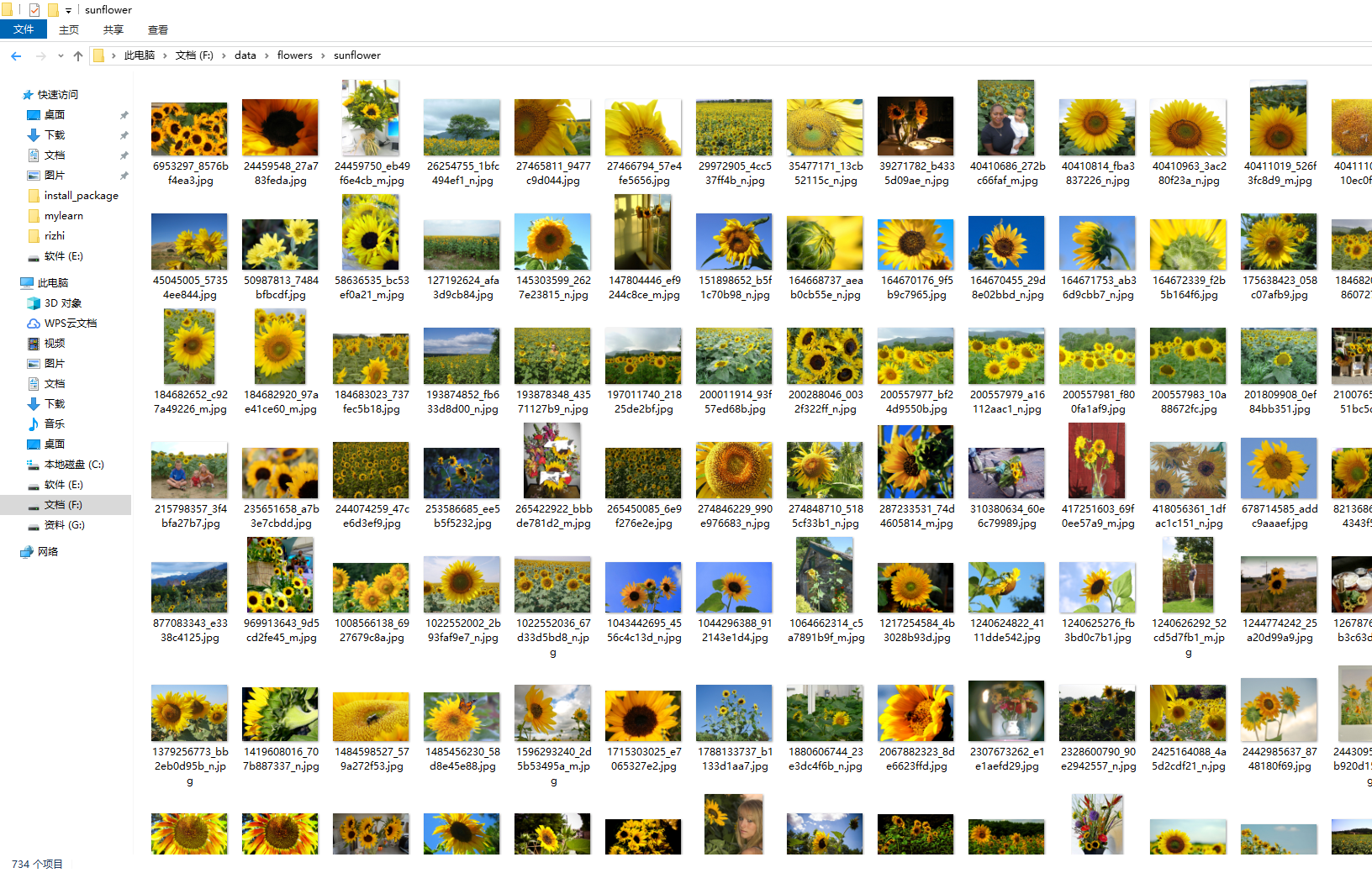
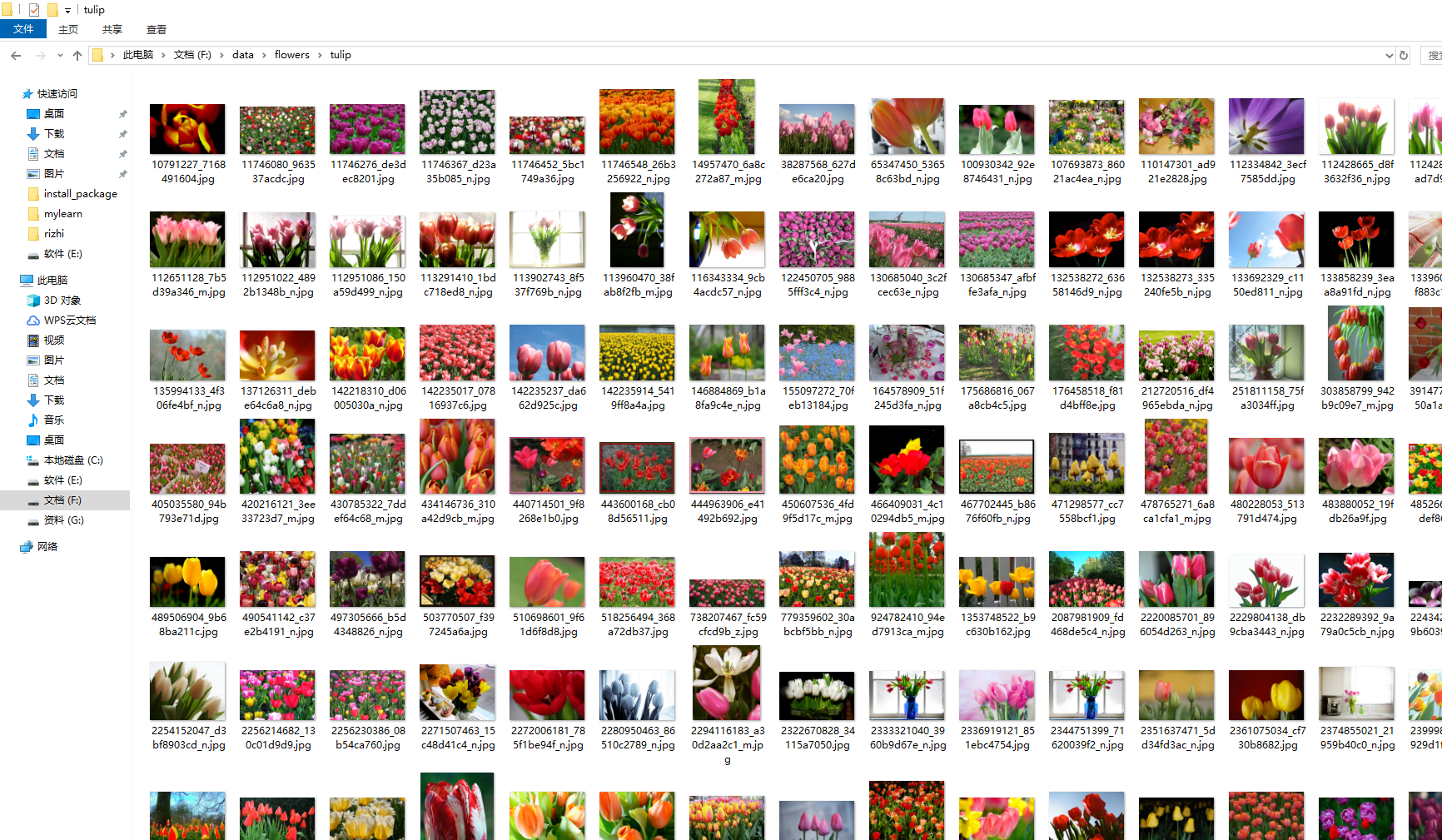
吴裕雄--天生自然 Tensorflow卷积神经网络:花朵图片识别的更多相关文章
- 吴裕雄--天生自然TensorFlow高层封装:使用TFLearn处理MNIST数据集实现LeNet-5模型
# 1. 通过TFLearn的API定义卷机神经网络. import tflearn import tflearn.datasets.mnist as mnist from tflearn.layer ...
- 吴裕雄--天生自然TensorFlow高层封装:使用TensorFlow-Slim处理MNIST数据集实现LeNet-5模型
# 1. 通过TensorFlow-Slim定义卷机神经网络 import numpy as np import tensorflow as tf import tensorflow.contrib. ...
- 吴裕雄--天生自然TensorFlow高层封装:Estimator-自定义模型
# 1. 自定义模型并训练. import numpy as np import tensorflow as tf from tensorflow.examples.tutorials.mnist i ...
- 吴裕雄--天生自然TensorFlow高层封装:Estimator-DNNClassifier
# 1. 模型定义. import numpy as np import tensorflow as tf from tensorflow.examples.tutorials.mnist impor ...
- 吴裕雄--天生自然TensorFlow高层封装:Keras-TensorFlow API
# 1. 模型定义. import tensorflow as tf from tensorflow.examples.tutorials.mnist import input_data mnist_ ...
- 吴裕雄--天生自然TensorFlow高层封装:Keras-RNN
# 1. 数据预处理. from keras.layers import LSTM from keras.datasets import imdb from keras.models import S ...
- 吴裕雄--天生自然TensorFlow高层封装:Keras-CNN
# 1. 数据预处理 import keras from keras import backend as K from keras.datasets import mnist from keras.m ...
- 吴裕雄 python 神经网络——TensorFlow 卷积神经网络水果图片识别
#-*- coding:utf- -*- import time import keras import skimage import numpy as np import tensorflow as ...
- 吴裕雄--天生自然TensorFlow高层封装:Keras-多输入输出
# 1. 数据预处理. import keras from keras.models import Model from keras.datasets import mnist from keras. ...
随机推荐
- Java 实现 栈
package Test; import java.util.*; public class Stack_test { public static void main(String[] args) { ...
- MySQL--存储引擎的特性
常用存储引擎的对比 特点 MyISAM InnoDB MEMORY MERGE NDB 存储限制 有 64TB 有 没有 有 事务安全 支持 锁机制 表锁 行锁 表锁 表锁 行锁 B树 ...
- python-day6爬虫基础之会话、Cookies、代理
由于前几天看电脑时间过长,在昨天的时候,两个眼睛就有点疼痛感觉,所以昨天晚上就没有学习,博客也没有跟着写,今早去校医院买了点药,上午把老师要求的电路板画完了,已经发出去做了,现在闲来无事,看了一会关于 ...
- 剑指offer【09】- 跳台阶
题目:一只青蛙一次可以跳上1级台阶,也可以跳上2级.求该青蛙跳上一个n级的台阶总共有多少种跳法(先后次序不同算不同的结果). 对于本题,前提只有 一次 1阶或者2阶的跳法. a.如果两种跳法,1阶或者 ...
- android studio 导入eclipse项目后的报错解决
1.如何导入: 2.导入的时候会让你创建gradle,一直下一步,不用修改 3.编译, a.会报编码格式错误,如果有中文会报这个错,修改成utf-8 b.找不到类,解决办法 右键工程 引入外部的包,重 ...
- Python字符串与列表
- NSIS增加打包文件夹
File /r "F:\rainwayDemo\exploer\RailwayLinesExploer\bin64\log" File /r "models" ...
- 2019-2020-1 20199324《Linux内核原理与分析》第七周作业
第六章 进程的描述和进程的创建 知识点总结 进程的描述 操作系统内核实现操作系统的三大管理功能以及对应的抽象概念: 进程管理(最核心)-- 进程 内存管理 -- 虚拟内存 文件系统 -- 文件 进程是 ...
- TimeHelper
import java.time.Duration; import java.time.Instant; import java.time.OffsetDateTime; import java.ti ...
- VisitsService
package me.zhengjie.monitor.domain; import lombok.Data; import org.hibernate.annotations.CreationTim ...
